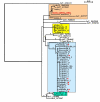Losing helena: the extinction of a drosophila line-like element
- PMID: 18377637
- PMCID: PMC2330053
- DOI: 10.1186/1471-2164-9-149
Losing helena: the extinction of a drosophila line-like element
Abstract
Background: Transposable elements (TEs) are major players in evolution. We know that they play an essential role in genome size determination, but we still have an incomplete understanding of the processes involved in their amplification and elimination from genomes and populations. Taking advantage of differences in the amount and distribution of the Long Interspersed Nuclear Element (LINE), helena in Drosophila melanogaster and D. simulans, we analyzed the DNA sequences of copies of this element in samples of various natural populations of these two species.
Results: In situ hybridization experiments revealed that helena is absent from the chromosome arms of D. melanogaster, while it is present in the chromosome arms of D. simulans, which is an unusual feature for a TE in these species. Molecular analyses showed that the helena sequences detected in D. melanogaster were all deleted copies, which diverged from the canonical element. Natural populations of D. simulans have several copies, a few of them full-length, but most of them internally deleted.
Conclusion: Overall, our data suggest that a mechanism that induces internal deletions in the helena sequences is active in the D. simulans genome.
Figures





Similar articles
-
Ongoing loss of the tirant transposable element in natural populations of Drosophila simulans.Gene. 2006 Jun 21;375:54-62. doi: 10.1016/j.gene.2006.02.008. Epub 2006 Apr 19. Gene. 2006. PMID: 16626897
-
The evolutionary dynamics of the Helena retrotransposon revealed by sequenced Drosophila genomes.BMC Evol Biol. 2009 Jul 22;9:174. doi: 10.1186/1471-2148-9-174. BMC Evol Biol. 2009. PMID: 19624823 Free PMC article.
-
Insertion sites of the transposable element mariner are fixed in the genome of Drosophila sechellia.J Mol Evol. 1991 Nov;33(5):450-6. doi: 10.1007/BF02103137. J Mol Evol. 1991. PMID: 1660073
-
Maintenance of transposable element copy number in natural populations of Drosophila melanogaster and D. simulans.Genetica. 1997;100(1-3):161-6. Genetica. 1997. PMID: 9440269 Review.
-
Birth, School, Work, Death, and Resurrection: The Life Stages and Dynamics of Transposable Element Proliferation.Genes (Basel). 2019 May 3;10(5):336. doi: 10.3390/genes10050336. Genes (Basel). 2019. PMID: 31058854 Free PMC article. Review.
Cited by
-
Losing identity: structural diversity of transposable elements belonging to different classes in the genome of Anopheles gambiae.BMC Genomics. 2012 Jun 22;13:272. doi: 10.1186/1471-2164-13-272. BMC Genomics. 2012. PMID: 22726298 Free PMC article.
-
Expression of the Retrotransposon Helena Reveals a Complex Pattern of TE Deregulation in Drosophila Hybrids.PLoS One. 2016 Jan 26;11(1):e0147903. doi: 10.1371/journal.pone.0147903. eCollection 2016. PLoS One. 2016. PMID: 26812285 Free PMC article.
-
TEtools facilitates big data expression analysis of transposable elements and reveals an antagonism between their activity and that of piRNA genes.Nucleic Acids Res. 2017 Feb 28;45(4):e17. doi: 10.1093/nar/gkw953. Nucleic Acids Res. 2017. PMID: 28204592 Free PMC article.
-
Helena and BS: Two Travellers between the Genera Drosophila and Zaprionus.Genome Biol Evol. 2018 Oct 1;10(10):2671-2685. doi: 10.1093/gbe/evy184. Genome Biol Evol. 2018. PMID: 30165545 Free PMC article.
-
The Hmr and Lhr hybrid incompatibility genes suppress a broad range of heterochromatic repeats.PLoS Genet. 2014 Mar 20;10(3):e1004240. doi: 10.1371/journal.pgen.1004240. eCollection 2014 Mar. PLoS Genet. 2014. PMID: 24651406 Free PMC article.
References
Publication types
MeSH terms
Substances
LinkOut - more resources
Full Text Sources
Molecular Biology Databases

